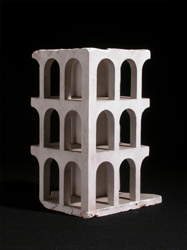Giovanni Guerrini
and E42
(Giovanni Guerrini e l'E42)
|
curators: Carlo Fabrizio Carli, Lela Djokic and Daina Maja Titonel
|

|
February 4 - April 3, 2010
catalogue edited by Carlo Fabrizio Carli and Daina Maja Titonel
 press release press release
|
On Thursday, February 4, 2010 at 6 pm the Nuova Galleria Campo dei Fiori will inaugurate the second part
of its exhibit dedicated to Giovanni Guerrini (Imola 1887 - Rome 1972). This exhibit focuses on Guerrini
the architect and his work of masterful decorations for the Esposizione Universale (E42), meant to be held
in Rome in 1942 to celebrate the 20th anniversary of the March on Rome (1922). The event was cancelled, however,
because of WWII.
Giovanni Guerrini - one of the greatest Italian figures of applied arts between the two world wars - was born in
Imola on May 29, 1887. He attended the Tommaso Minardi Design School of Faenza and later the Art Institute of
Florence. In 1913, in Rome, Guerrini took part in the Prima Secessione exhibit. Subsequently, his work was shown
at top exhibitions such as 11 Venice Biennales, the Rome Biennale (1921, 1923, 1925), the Rome Quadriennale and
the first Mostra del Novecento Italiano in Milan (1926).
In 1927, Guerrini moved to Rome and that same year was chosen to be artistic director of ENAPI, the national
association of artisans and small industries. In 1938, he and fellow architects Bruno La Padula and Mario Romano
designed the Palazzo della Civiltà Italiana in EUR (Rome), which to this day remains Guerrini's most
celebrated architectural work.
In 1941, along with Achille Capizzano, Franco Gentilini and Giorgio Quaroni, Guerrini was selected to design
the mosaics (circa 3,000 square metres) for the main hall of the Palazzo dei Congressi in EUR. In 1939 he created
six large, black, monochrome mosaics for the Palazzo degli Uffici Fountain. The other 12 were conceived by
Gino Severini and Giulio Rosso.
Giovanni Guerrini died in Rome on March 20, 1972.
Approximately 40 works will be shown in this second exhibit, including about 15 original drafts for the Palazzo
della Civiltà Italiana, dated circa 1937; six sketches for the mosaics of the Palazzo degli Uffici Fountain
(c. 1939); and another 15 preparatory drawings for the mosaics, which were never realised, for the main hall
of the Palazzo dei Congressi in EUR (c. 1941).
The show furthermore includes a plaster model of
the Palazzo della Civiltà Italiana (c. 1938).
|

Giacomo Balla
capricci romani
|
curators Lela Djokic and Daina Maja Titonel
|
October 21 - December 31, 2010
catalogue edited by Elena Gigli
|
Thursday, October 21st 2010 at the Nuova Galleria Campo dei Fiori opens an exhibit dedicated to
Giacomo Balla (Turin 1871 – Rome 1958), curated by Lela Djokic and Daina Maja Titonel.
In 1895 a young Balla arrives to the capital of united Italy, and discovers Rome's tucked away corners
which tell quite a more colourful and boisterous story than the one engulfed in mist from his native Turin.
He is captivated, so much, that in 1901 he dedicates a series of six works to characters at the forestage
of the street, five of which are included in the exhibit.
Yet the wandering vendors that offer fresh ricotta, cornetti, brooms and comforters, bay sticks and
lucky charms, are not the protagonists of a social column depicted with amused complacency.
It's the enthusiasm of having discovered a new world that dictates the expressive style that the artist
offers, moving past the late eighteen century models, and manifesting the talent of his modernity.
Balla paints streets, corners of walls and shops. He isolates his figures pulling them out from the crowd
that would have attributed to the scene a charicaturistic feel. The paint stroke is free and simple,
and reminds us some spasmodic self-portraits to come.
The characters move to the rhythm of spirited gesticulation that gives life to a dynamic imagery,
one that lives also in the shop sign which appears next to the Bottega del macellaro; a style
that foreshadows Balla's personal exploration of movement during the Futurist movement.
What also stands out is the novelty of the photographic composition. The figures are defined within a large
setting composed of paving of the street, delimited by a horizontal line which is notably raised.
In the background the shops are aligned, framed such as their tops are cut off. Just as in the
famous paiting Il Fallimento (1902), finding here a suggestive foreshadowing of the doors
of the shop that serves as a backgournd to Venditore di cornetti.
Giacomo Balla's audacious innovation is, however, still more surprisingly attested by the juxtaposition
of images and graphic elements. In exploring the bidimensionality of the scene, the artist writes on the
lower of three boards the phrases called out by the vendors. He does this with a linguistic verism that
leads him to multiply the vocals ("ricooootta freeeesca"), just as if to reproduce the voices of the
characters. It's a sound which accompanies and completes the pictoral representation.
They are talking
portraits.
Only the extraordinary creativity of Giacomo Balla could introduce into these canvases the magic of
painted voices.
|
|

